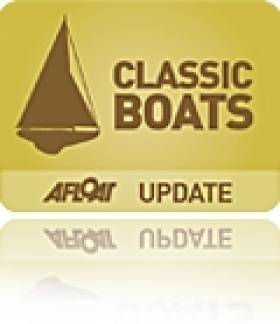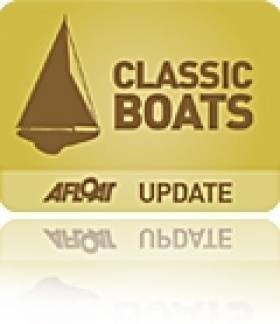Displaying items by tag: historic craft
Naomh Éanna Aran Islands Ship TV Documentary Airs Tonight On TG4
#naomheanna – Donncha Mac Con Iomaire's maritime programme on the Naomh Éanna ship airs tonight on TG4 at 21:30. Rusted and with little future she was sentenced to be scrapped, until a few men embarked on a plan to bring new life to the Naomh Éanna. The news of the bid to rescue her from Grand Canal Dock was told by Afloat.ie last February and now the tale makes the small screen.
The Naomh Éanna provided all the neccessities the three Aran Islands had with the mainland for 30 years. CIÉ's rivited ship brought everything from summer students and sheep to Galway, and ice cream and coal to the windswept isles. The Naomh Éanna was at the end of a great era of shipbuilding in Dublin but was ill-designed to service three islands in which she could only moor at one pier! The curragh men of Inis Meáin and Inis Oirr battled the wild Atlantic to keep connected to the outside world.
If you missed it the Docu is now on the TG4 player here
#historicboats – The fiftieth Birthday celebrations of the Old Gaffers Association on the river Liffey on the June Bank Holiday will include a Gaff Rigged Droleen (Sail No. 13-1) that once sailed off Bray in Co. Wicklow at the end of the 1800s.
A local group of Wicklow maritime enthusiasts have come together to build a new fleet of the 12-foot boats.
The original Bray Sailing Club Droleens first sailed off the beach in 1896 and the newly formed Bray Droleen Association wish to see the new fleet continue to sail under the current Bray Sailing Club Burgee.
The Bray Droleens were specifically designed by Mr Ogilvy to be sailed off the Bray shore in County Wicklow.
The group is going to build a fleet of Bray Droleens in collaboration with community and business organisations.
By doing so, the aim is to promote, restore and record some of Bray's maritime golden history.
The Droleen will be based at Poolbeg sailing club at the OGA weekend.
The fleet of at least six will be available to community groups, businesses and visitors for sailing, fishing, rowing and racing on Bray's waterfront, adding an additional experience to Bray's seafront.
Droleens are a one design class, 12ft long, 6ft wide, gaff rigged dinghies with spinnakers.
The project will involve young and old people in local groups building and using these classic boats.
#fife – Classic Yachts will grace the waters of the Clyde in Scotland this summer between 28th June to 5th July.
This will be the fourth gathering of the much admired William Fife designed yachts. His work was acclaimed in his lifetime and continues to be so, celebrated this year by the The Fife Regatta 2013. During the golden age of the Victorian era through to 1938 when his yard at Fairlie, North Ayrshire built his last yacht Solway Maid, Wm. Fife was a master of his craft. Twenty of these Classic Yachts are set to return to the Clyde again.
The inaugural Fife Regatta was held in 1998, and thereafter in 2003 and 2008. A number of owners with a shared passion and enthusiasm for Fife yachts have made this pilgrimage back to their home waters. The Dragon and Wheatsheaf emblem engraved in the bow of Fife's yachts is symbolic of the level of craftsmanship in each creation. Fife yachts continue to attract attention worldwide with exacting restoration projects and the sheer pleasure of sailing them.
Two fabulous boats, Kentra and Astor, celebrate their 90th birthdays this year. Kentra, a 100ft Gaff- Ketch has been in storage for nearly seven years, is being re-launched for the regatta. Astor, an 86ft Schooner, will be coming all the way from California for the occasion. Hatasoo, the 19ft Gaff sloop build in 1894 will be the oldest yacht. She will be the local Clyde entrant from McGruers yard, Clynder on the Gareloch. The larger yachts will include Moonbeam III (105ft), Aventuress (100ft) along with Kentra. Seabird and Oblio are more recent builds from William Fife drawings and confirm how these yachts have a place in modern times.
For some of their Owners and Crew this will be their first visit on the Clyde. For Mignon, it will be her fourth Fife Regatta and she will be the only yacht to have competed in all of these special events.
To be enchanted by these fine creations under sail keep your diary free from the end of June. The yachts will begin in Largs and will have passage races to Rothesay, Tighnabruaich and Portavadie before returning to Largs.
The itinerary of the event is as follows:
Friday 28 June No racing Largs Yacht Haven
Saturday 29 June Round Cumbraes Race Largs Yacht Haven
Sunday 30 June Largs to Rothesay Race Rothesay
Monday 01 July Cruise Rothesay to Tighnabruaich Tighnabruaich
Tuesday 02 July Portavadie/Inchmarnock Race Portavadie Marina
Wednesday 03 July Lay Day Portavadie Marina
Thursday 04 July Portavadie to Largs Race Largs Yacht Haven
Friday 05 July Kings Course Race & Prize giving Largs Yacht Haven
In conjunction with the Year of Natural Scotland this event embraces our natural environment through water, wind and scenic surroundings. It is a show case of Scotland's heritage and the sport of Sailing. This will be a classic seven-day event and one to enjoyed from many of the beautiful vantage points on land or sea.
William Fife III (1857 – 1944) was from a family of boat builders and designers. His yard was in the small village of Fairlie on the Firth of Clyde. After his death the yard was run for a short period by his nephew before being sold. The yard then became Fairlie Yacht Slip Ltd., where fishing vessels were built and yachts repaired. The yard was demolished in 1985 and little remains of the yard. A commemorative sculpture was erected in 2011 on Bay Street.
Wm. Fife designed and built, Shamrock I, was the yacht skippered by Sir Thomas Lipton which challenged for the Americas cup in 1899. It is fitting that 2013 is also an Americas Cup challenge year and the Louis Vuitton Challenge series for the Americas Cup starts in the USA during the Fife Regatta. Compare these two events and see how sailing design has developed over the last century.
#historicsail – Britain's Surviving Working Craft by Paul Brown is a celebration of those surviving traditional boats that once worked under sail in the coastal waters of the British Isles. Published in association with National Historic Ships UK, this £16.99 paperback original includes a concise history for the surviving craft, details of their working service, conservation, current location and use, and basic particulars such as dimensions and tonnage.
For centuries the inhabitants of the coastal communities of the British Isles depended on the sea for their livelihood, with lives and fortunes closely tied to the success of the craft that sailed. The seas around our islands teemed with these craft, and their crews had to battle with the forces of nature risking their lives in the process. These vessels were highly specialised, and many thrived right through until the era of the motor or steam power.
Some types were lost forever, often without any accurate record being made of their design and characteristics. Fortunately, due to a surge of interest and a conservation project, many former working sailing craft survive from the once large fleets of distinctive local types, such as the Humber keel, Brixham trawler, Cornish lugger, Scottish fifie and Thames spritsail barge.
The book documents these specialist vessels, concentrating on those of 40ft and over.
Each type is introduced and its evolution tracked, with the main characteristics of the traditional design described.
It includes a concise history for the surviving craft, details of their working service, conservation, current location and use, and basic particulars such as dimensions and tonnage.
The book is illustrated with colour photographs, many taken by the author and others sourced from vessel owners and National Historic Ships' archives.
Paul Brown is a retired university lecturer and senior manager with a lifelong interest in ships and the sea. He is now a writer and photographer on maritime subjects, and a consultant to National Historic Ships. His previous books include Maritime Portsmouth - A History and Guide (Tempus 2005, History Press 2009), Britain's Historic Ships (Conway, 2009) and Historic Ships – The Survivors (Amberley, 2010). He also contributed to Ship (Conway, 2010). He lives in Northamptonshire.



























































